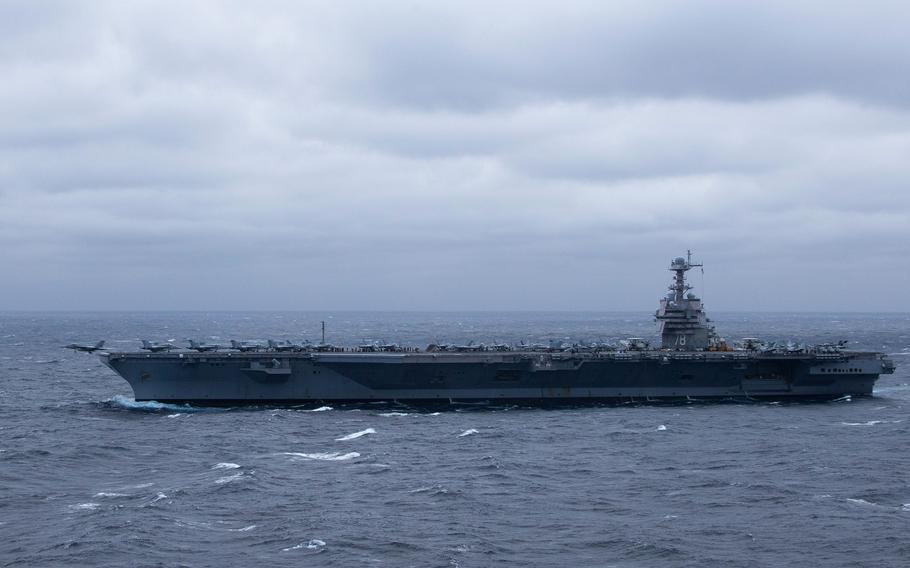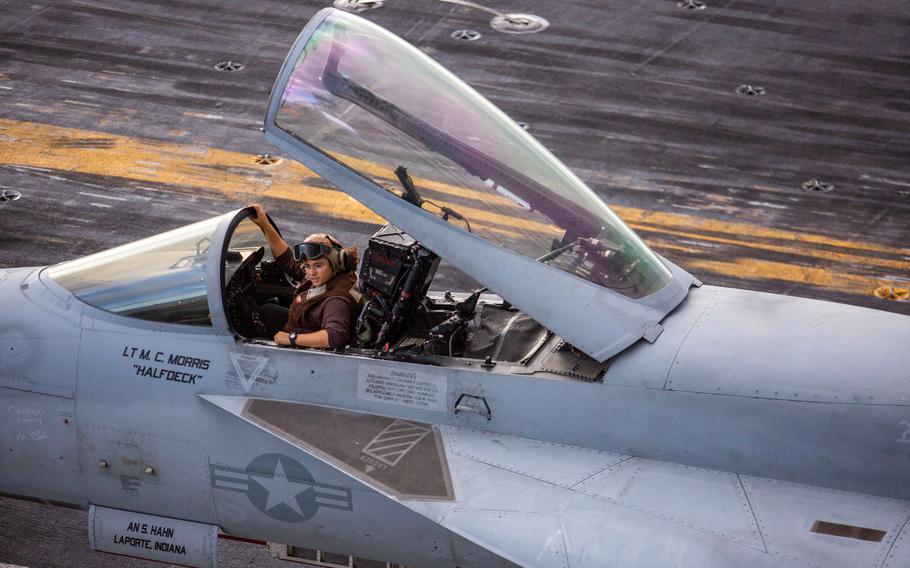
The aircraft carrier USS Gerald R. Ford transits the Atlantic Ocean while conducting flight operations Oct. 23, 2022. (Jackson Adkins/U.S. Navy)
(Tribune News Service) — “USS Gerald R. Ford: The Biggest and Baddest” reads a T-shirt in the store aboard the Navy’s newest aircraft carrier. The slogan appeared again on a poster not far from the galley. And it was repeated by the ship’s captain as he overlooked the flight deck from the bridge.
Since the early 2000s, the Navy has marketed the Ford as the future of American warships. The ship — 1,106 feet in length — is jam-packed with 23 never-before-seen technologies meant to “carry the Navy into the 21st century.”
“This will be the most powerful warship our Navy has put to sea — probably any Navy ever,” said Paul Lanzilotta, commander of the Ford.
But supporters of the Ford say its $13 billion price tag gave it a bad name, with the cost overshadowing the Ford’s capabilities.
At $4 billion over budget, the ship is the costliest single item on the Department of Defense’s shopping list — a stigma the Navy has struggled to shake while working to differentiate it from Nimitz-class carriers, which come at a fraction of the price.
Dozens of sailors — each donning a helmet, goggles and hearing protection — scurry around the flight deck in choreographed chaos. They step almost without looking over ropes, chains and cords, quickly resetting the arresting gear, directing a taxiing aircraft to the launch area or fueling a waiting aircraft. Only hand signals are used to relay information as heavy ear protection muffles sound from the outside world.
But it can’t block out the chest-rattling noise of fighter jets launching from or landing atop the carrier as it cruised the Atlantic in October. The Ford completed a 53-day deployment last month, during which the Navy invited reporters aboard to see some of the technology in action.
The carrier’s new electromagnetic-powered aircraft launch system (EMALS) and the advanced arresting gear are two of the much-touted technologies unique to Ford-class carriers. EMALS uses stored kinetic energy and solid-state electrical power conversion to propel an aircraft along a track and off the carrier, while the arresting gear is a turbo-electric system designed for more controlled deceleration of aircraft. The technology, the Navy said, means the air-wing can get into the air — and return to the battle after rearming and refueling — faster than with the traditional steam-and-hydraulics systems that have been the mainstay for decades.
“It does feel a little different, the acceleration on Nimitz (when being catapulted off the ship) is kind of a punch all at once. This (a Ford catapult launch), you will feel a more graduated acceleration as you go down the (catapult). It’s a little easier on your neck. When you trap (land) on Nimitz, everything tends to get thrown forward in cockpit. (The arresting gear wire) does feel played a little differently (on the Ford),” said Cmdr. John Peterson, the Ford’s air officer.

A pilot sits in the cockpit of a jet in between flight operations on the flight deck of the USS Gerald R. Ford CVN-78 on Friday, Oct. 7, 2022. (Kendall Warner, The Virginian-Pilot/TNS)
To adapt to the needs of the new system, the Ford’s crew has more electricians and fewer traditional mechanics, compared to the Nimitz, contributing to a reduction of personnel by around 500 sailors.
While the Ford’s EMALS and advanced arresting gear have been widely promoted by the Navy as a selling point, the move away from steam was criticized by President Donald Trump, U.S. Naval Institute News reported in 2017, who said the automation of the system was “no good” technology that cost millions more than the steam system.
“It’s very complicated — you have to be Albert Einstein to figure it out,” Trump said.
And in 2021, an annual report from the Pentagon’s top weapons tester doubted the Ford could meet its sortie generation rate requirement and achieve a self-defense requirement.
“Poor reliability of key systems that support sortie generation on CVN-78 could cause a cascading series of delays during flight operations that would likely negatively affect CVN-78′s ability to generate sorties. The reliability of these critical subsystems represents the most risk to the successful completion of CVN-78,” the report from the director, operational test and evaluation said.
But the ship’s chief engineer, Cmdr. Homer Hensy, said the move from steam to electromagnetics was a “necessary” investment — necessary to save money, necessary to reduce downtime during maintenance cycles and necessary for the Navy to maintain its edge.
“I think a lot of people have been staring at the dollar signs. ... There were a lot of decisions made to put advanced technology on the Ford instead of spreading it out across two or three aircraft carriers because it is what we needed now,” said Hensy, as he stood in a hangar bay of the Ford while it cruised the Atlantic.
The cutting edge technology was the driving force behind the warship’s growing costs. The technology, previously unproven, pushed the Ford’s first deployment back by four years after on-shore testing revealed unexpected problems that delayed the installation of key components of the ship and required hundreds of millions of dollars to fix.
“The advanced weapons elevator — there’s no lab for that. The Navy just dreamt it up and bought it ... I understand it is not a cheap technology, but it’s the price of freedom,” Hensy said.
The Government Accountability Office reported the arresting gear cost $149 million — nearly double its original estimate of $75 million. And the cost of the electromagnetic catapult system climbed from $318 million to $664 million.
According a Congressional Research Service report dated Aug. 26, 2022, by Ronald O’Rourke, the Navy struggled to control the Ford’s costs “for years,” which he stated in his report was fueled by “an unrealistically low” $10 billion estimate provided back in 2008.
The original number, O’Rourke’s report reads, “might have reflected an underestimate of the intrinsic challenges of building the then-new Ford-class design compared to those of building the previous and well understood Nimitz-class design.”
The warship’s 11 advanced weapons elevators were among the most problematic of the new technologies, which were delivered more than a decade late.
“But it was worth it,” said Lanzilotta, who was assigned commander of the Ford when just six of the elevators were fully functioning.
Below the flight deck, a weapons elevator effortlessly glided down to the hangar bay as Chief Warrant Officer 2 Jeff Towry demonstrated how the system hoists bombs and armament from the Ford’s magazines to the flight deck, to be loaded onto aircraft. Like the catapults, the elevators are electromagnetic — replacing a cable-driven system — and now operate through WiFi.
“This platform is ultimately floating in the air when it is in transit. The magnetics pull it up and down,” Towry said.
Seven of the elevators operate in the ship’s lower stages in the main magazine areas, with three in the upper stages and one utility elevator that serves the hangar bay and flight deck. The system features two ballistic hatches, protecting the rest of the ship from the magazine where all ammunition is stored, which Towry said would not be possible unless it was a wireless system.
Cmdr. Jim Fish, weapons officer for the Ford, said the elevators are also stronger and faster than those on Nimitz-class carriers. Increased strength and speed, he said, equal reduced vulnerability.
“When we do combat reloads and routine operations, that’s where the real critical value comes with these elevators. All the technology we brought into it allows redundancy, allows for reliability, survivability, all these ‘ilities’ that are very important to us to be combat ready,” Fish said.
While the system development took longer than expected, the elevators ran as advertised during the ship’s two-month deployment, operators and officials said.
Defense analyst Bryan McGrath said the Ford’s challenge in joining the fleet is not unique to the advanced warship. And he predicts future Ford-class carriers — John F. Kennedy, Enterprise, and Doris Miller, which are in production — will be delivered quicker and without breaking the bank.
“To some extent, it is the nature of the beast when you’re trying to do something that’s incredibly complex. And to some extent, it’s a function of an acquisition and construction system that could use some optimization and some work,” said McGrath, who is the director of Ferry Bridge Group, a defense and national security consultancy.
TheKennedy was procured in Fiscal year 2013. The Navy estimates it will cost around $12.7 billion.
“The ship is being built with an improved shipyard fabrication and assembly process that incorporates lessons learned from the construction of CVN-78 (USS Gerald R. Ford),” O’Rourke said in the August report.
Among the lessons learned is the dual band radar, a new flush-mounted, two-phased array radar meant to replace the spinning radar on the older class carriers, that crew members said was powerful — maybe even too powerful.
“If I have a threat, (the dual band radar) can identify (and keep) a precision track on threats and never lose contact wherever the track goes. I would say it probably is more powerful than you need to do with carrier missions we had done in the past,” said Cmdr. Tom Pilkerton, combat systems officer for the Ford.
U.S. Naval Institute reported the Navy scrapped the radar in 2015 in an effort to cut costs. Rear Adm. Thomas Moore, program executive officer for aircraft carriers, stated at the time that analysis showed the carrier didn’t need all the system’s capabilities. Instead, future Ford carriers will be outfitted with the Raytheon-designed air and missile defense radar, now officially named AN/SPY-6, which the Congressional Research Service reports will save around $180 million.
McGrath said future costs will also be lessened by the Navy’s block buy purchase of future carriers Enterprise (CVN-80) and Doris Miller (CVN-81), a contract awarded to Huntington Ingalls Industries in 2019. Buying the carriers two-at-a-time, McGrath said, stabilized the industrial base and will ultimately save around $4 billion.
“That is a significant savings because you are buying at scale — the steel, the parts,” McGrath said.
According to O’Rourke’s Congressional Research Service report, the Enterprise and Doris Miller are estimated to cost $12.8 billion and $12.9 billion respectively before factoring in the $4 billion savings.
“But it’s worth every penny ... The acquisition costs — I understand, it gets people’s attention. But the bottom line is that the USS Ford will get people’s attention for 50 years and we can’t lose sight of that,” McGrath said.
caitlyn.burchett@virginiamedia.com
©2022 The Virginian-Pilot.
Visit pilotonline.com.
Distributed by Tribune Content Agency, LLC.